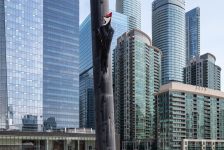Towering over the south entrance of the Metro Toronto Convention Centre (MTCC) is FASTWÜRMS’ sculpture, Woodpecker Column. This massive steel work rises from the ground in stark but welcome contrast to the concrete jungle behind it. Mimicking the trunk of a gnarled tree, the column is punctured with many holes and the culprits of this damage are not hard to see! Two large birds, a pileated woodpecker and a yellow-bellied sapsucker, have their beaks poised and ready to peck through metallic bark. As the art of FASTWÜRMS is often inspired by nature, this installation site was well-suited for the work. The lands on which the MTCC was built formerly housed a swamp where waterlogged and decaying trees would have attracted indigenous woodpeckers such as these. When viewing the sculpture at night, even from the Gardiner Expressway, FASTWÜRMS’ column stands out thanks to the colourful LED lighting concealed inside.

Woodpecker Column

FASTWÜRMS
Founded 1979
- Steel and fibreglass
- 1997
- 30.5 m column, 4.9 m woodpecker, 2.7 m sapsucker
- 222 Bremner Blvd, Roger's Centre, Toronto
About the artwork
About the artist
FASTWÜRMS is an artist collective based out of Toronto and Creemore. Formed in 1979, the collective was originally comprised of three members: Kim Kozzi (Kim Kozolanka from Ottawa), Dai Skuse (David Skuse from England), and Napo B. (Napoleon Brousseau from Ottawa), who met while employed as security guards at the National Gallery of Canada. Upon moving to New York City in the 1980s, Napo B. formally left the collective in 1991. Kozzi and Skuse continue to produce artworks under the FASTWÜRMS name. The collective’s multidisciplinary practice takes on many forms including video, immersive installations, performance and public art, to explore the themes of identity, humour, magic and social exchange. FASTWÜRMS strongly identifies with fringe communities and sub-cultures, often employing punk aesthetics and witchcraft as tools to examine identity politics and social interaction. The collective also celebrates their working class background, crediting much of their “determined DIY sensibility” to the untrained artists have learned from. Currently living and creating from their home in rural Ontario, FASTWÜRMS also spend their time teaching studio art at the University of Guelph. Their work has been exhibited extensively both in North America and internationally at venues such as the Power Plant (Toronto), the Contemporary Art Gallery (Vancouver), the Seoul Museum of Art (Korea), and the 2006 São Paulo Biennial (Brazil).
Fun facts
- The name FASTWÜRMS comes from a technique of Super 8 film editing that collective member Kim first created in 1979. This fast intercut "punk" style of assembly was built physically, using clothesline and pegs to hang "wurms", or verious lengths of short film, by their heads and tails.
Engagement questions
- How does nature impact your daily life in the city?
- How does this work make you consider the city around you?
